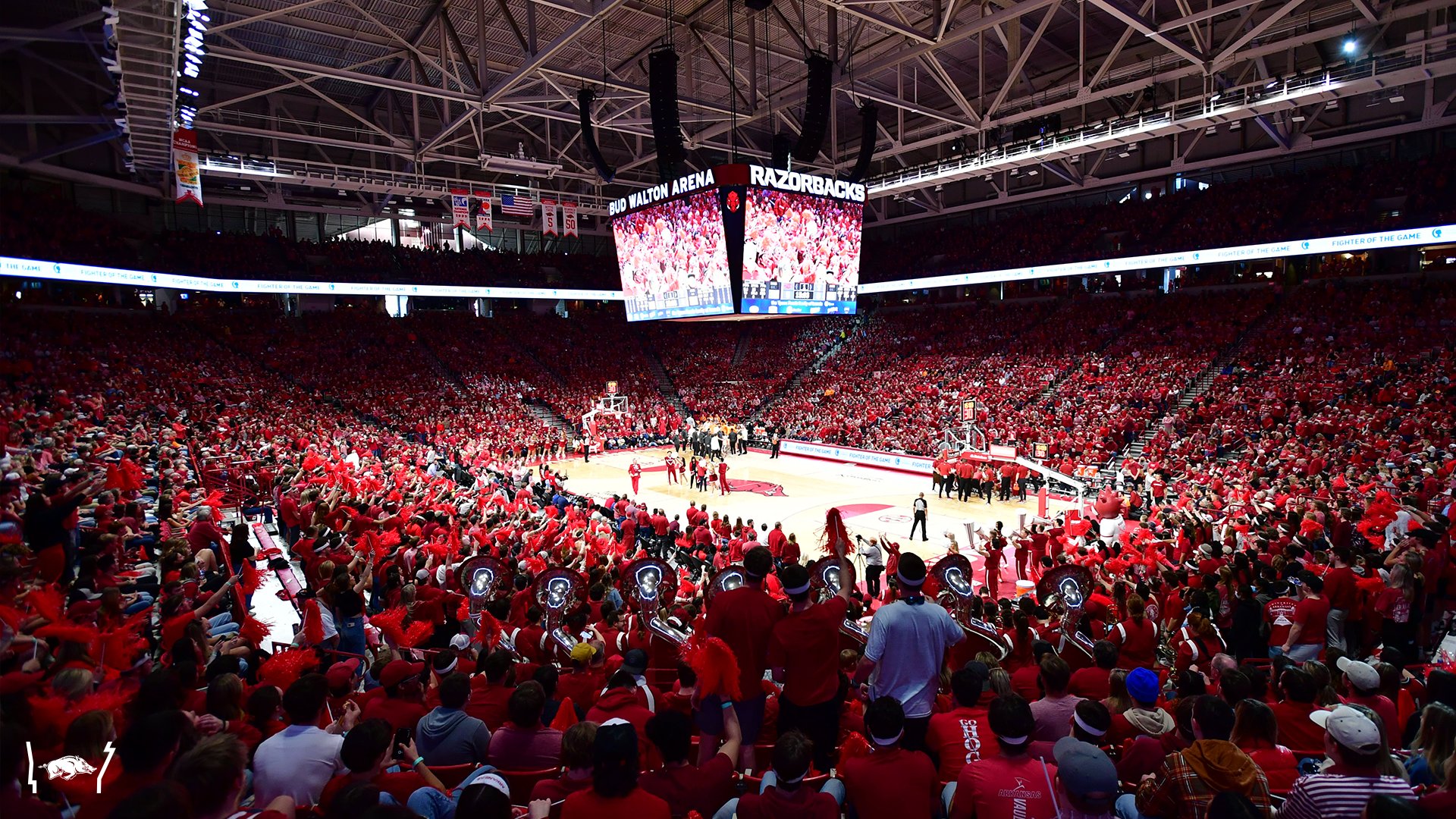It all comes down to this. After starting 0-3 in SEC play and losing a home-ish game to Hofstra, who thought Arkansas would enter the final game of the regular season with a chance to call themselves SEC champions, or at least capture the 2-seed in the SEC Tournament for the second straight year?
As we discussed in the weekend preview, Arkansas locks up the 2-seed with a win in this game and falls to the 3 or 4 with a loss, depending on how Kentucky fares in Gainesville. That’s two straight double-bye seasons under Eric Musselman, after Mike Anderson had just two in his eight seasons.
So this has been an entertaining, successful season no matter what happens in Knoxville. But why not go out and give us one more surprise?
Meet the Vols
Confused? Check out the advanced stats glossary to learn more about the stats cited here.
Arkansas’ 58-48 win over the Volunteers in Fayetteville was one of many highlights at Bud Walton Arena this season. The Hogs’ defense clamped down and offense prodded along despite an off-game from JD Notae, who fouled out in 24 minutes. Another reason to get excited: under Eric Musselman, Arkansas is 13-3 in games against an opponent that Arkansas has already faced that year, including 10-1 over the last two seasons.
As always, our two models make picks. The matchup model constructs a predicted box score based on team stats, while the traditional model uses each team’s adjusted efficiencies and adds a momentum factor.
- Matchup Model: Tennessee 75, Arkansas 67
- Traditional Model: Tennessee 79, Arkansas 72
Those picks seem really high to me, especially the second one, but then again, the LSU projection seemed high and the over hit anyway.
Team Profile

The traditional model likes Tennessee by just under four points on a neutral floor, and Thompson-Boling Arena isn’t a neutral floor. The Vols haven’t lost there yet and took down Kentucky, Auburn, and Arizona within those friendly confines. Tennessee’s homecourt advantage this season is +3.95 points per game, good for 5th-best in the SEC. (That’s how much better Tennessee performs at home on average compared to the neutral-floor model projection.)
The Hogs have been the better team in the last 10 and last 4, but these are the two hottest teams in the conference.
Player Profile

Unlike recent opponents that have caused problems for Arkansas’ defense, the Vols are extremely guard-heavy and lack a dominant big man. We’ll break down Rick Barnes’ motion offense below, but it traditionally includes an old-school low-post man who works within an offense designed to give him deep paint touches. But that low-post man doesn’t exist on this team, especially since Olivier Nkamhoua was lost with a season-ending injury several weeks ago.
From watching the Hogs this year, it sure feels like opposing bigs have given the Razorback defense problems, while the Razorbacks have mostly shut down opposing guards. But the eyes can be deceiving, so I decided to chart every opponents’ game score against every other opponent by position, and put the results in a table. Here’s how each position has performed against Arkansas this year, and how the Hogs rank against each:

Well, then. I’m not sure I’ve ever seen a chart more accurately describe what I think I’ve been seeing on the floor. Also, Au’Diese Toney has another year of eligibility. I thought you should know that, since he’s the guy normally defending the shooting guards.
Okay, so now that we’ve established that the Hogs are strong against off-ball guards and weak against power forwards and centers, we see the crux of Tennessee’s problem. The Vols’ best player is a shooting guard, and Tennessee has just one efficient big: John Fulkerson, who comes off the bench. If Tennessee is going to win this game, the Vols can’t rely on Santiago Vescovi and instead need to find a way to get the next four guys on the list above involved.
When Tennessee has the rock

The Vols will either need to get hot from 3 — something no one has done against Arkansas in the last 15 games — or crash the offensive glass, a place Arkansas’ defense has been vulnerable in recent games. The Razorbacks’ strong interior defense combined with Tennessee’s issues drawing fouls are the main reason the Vols offense struggled in the first matchup.
Tennessee’s motion offense
Now that we know that Tennessee’s offense has some inherent disadvantages against the Razorback defense, let’s look at what Tennessee is trying to do with its guard-heavy approach and how things might go differently this time.
Rick Barnes is a motion offense coach. He ran it at Texas and runs it at Tennessee now. The term “motion offense” is a catch-all term to describe an extremely common offensive approach in basketball that is built around — you guessed it — a lot of motion. Continuous motion away from the ball has the effect of getting opposing defenders out of position. Teams will use it to neutralize shot blockers or take advantage of quicker athletes.
Here, the Vols get great movement away from the ball to get Arkansas’ defense all out of sorts:
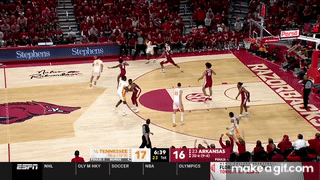
Vescovi actually misses this wide-open 3, which is obviously concerning: he’s not missing that shot in Knoxville. I’m not even sure who was supposed to be on him: Chris Lykes was trailing him on the opposite baseline, but Lykes thought he had passed Vescovi off to Trey Wade and Jaylin Williams. No one ends up closing out in time.
Tennessee’s motion offense today is a bit different from when Barnes first got to Knoxville. The Vols got steadily better in Barnes’ first four seasons, reaching their peak with a 31-6 team in 2019 that reached the Sweet Sixteen. That team was led by Grant Williams, who won SEC Player of the Year honors. That Tennessee team was so good at getting Williams deep touches in the paint. He would routinely catch the entry pass on the low block, allowing him to go straight up to the basket:
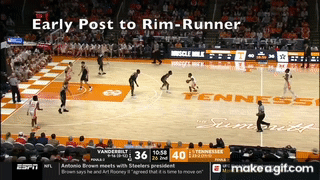
But things have changed. There’s no Grant Williams on this Tennessee, and by my count, Tennessee didn’t get a single bucket on a deep paint entry against Arkansas in the first game. Instead, the Vol forwards play a lesser role that complements the guards.
Here are the basic principles of this Tennessee offense. First, the quick attack:
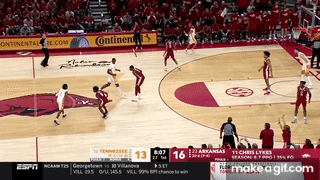
Some motion offenses are slow and deliberate, but this one isn’t. The Vols love to use Kennedy Chandler as an attacker on dribble drives early in the shot clock. Think of it like a quick audible in football: whatever play you’ve called, if you see a freshman corner 1-on-1 with Treylon Burks, you’re throwing it deep to him. If Chandler like the look, he goes.
Chandler doesn’t use the high ball screen and beats Lykes off the dribble. Notice Vol forward Uros Plavsic screening Jaylin Williams out of lane so he can’t help. Plavsic’s screen also catches Trey Wade who was also trying to help.
These downhill attacks from the guards are the main reason Barnes got so frustrated with the four charges that Williams drew in the first matchup. Here’s Vescovi thundering into the lane with no plan on a quick attack:
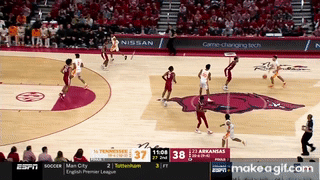
Look, the call itself is ticky-tack, probably the most ticky-tack of the four that Williams drew, but the reason the official gave it to him was that Vescovi had no plan and no body control. It is called a “player control foul” after all.
Obviously, the block/charge call probably won’t be called as friendly in Knoxville as it was in Fayetteville. So what are Arkansas’ other options for defending this dribble drive? Well, the easiest solution is to switch at the high ball screen, as Notae and Umude do here:
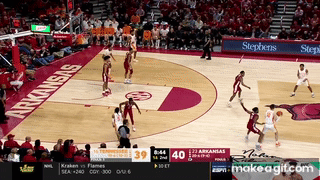
This takes away the dribble drive, so Chandler launches an ill-advised 3, which he almost airballs.
The Hogs would love to force this constantly, but that’s not always an option: what if Jaylin Williams’ man is the screener? All year, the Hogs have played drop coverage with Williams. All that means is that when Williams’ man goes for the high ball screen, Williams doesn’t go with him. He stays back in the lane (he “drops”), where he’s more valuable as a defender. The on-ball defender will fight through the screen, but Williams is prepared to deal with a dribble drive.
That’s the sequence where Williams has to be careful. He’s in position to take a charge when he drops, but you can bet Tennessee’s guards — and the home crowd — will be hyper-aware of his presence. A couple quick fouls on him and this game could change in a hurry. If Tennessee insists on dribble drives against drop coverage, the Hogs have some ways to protect their big man: changing the way they attack the screen with the on-ball defender, or stunting with a wing defender. If I see any of these during the game, I’ll try to get a clip for the Box Score Breakdown.
If the quick attack gets taken away, the Vols have a nice counter, finding the trailer:
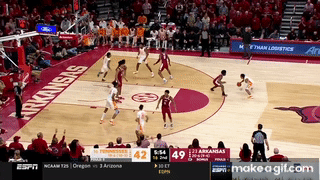
Again, Josiah-Jordan James misses this wide-open 3 and it’s fair to say he probably hits that in Knoxville.
Often, the trail guy will be the forward that set the high ball screen (also watch Williams execute the drop coverage here):
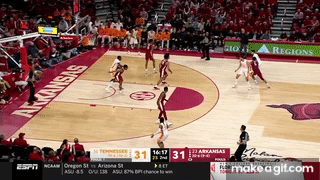
Again, the Vols missed this shot. James was wide open because the Hog defenders got tangled up with Chandler after he passed back to the trailing man.
Another common sequence is having the trail man catch and reverse the ball quickly to other side. Again, the goal here is to get the defense out of position:
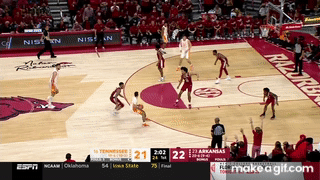
Plavsic executes the ol’ screen-catch-reverse-screen to get a high-percentage shot for Vescovi… who misses it, although both Au’Diese Toney and KK Robinson do a great job of harassing Vescovi after the catch, making the shot quite a bit harder.
When Arkansas has the rock

If Arkansas’ defense matches up well with Tennessee’s offense, then something close to the opposite can be said for the other side of the ball. We discussed Tennessee’s offense at length, but they’re only this good because of their defense, which is able to defend inside the arc, secure defensive rebounds, and force turnovers at a high rate.
Tennessee will mix zone and man, which contributes to their high 3-point rate allowed. In the first matchup, the Vols went to a 2-3 zone late, which seemed to make sense given Arkansas’ struggles to make 3-pointers. But as they have so many times recently, the Hogs immediately punished it:
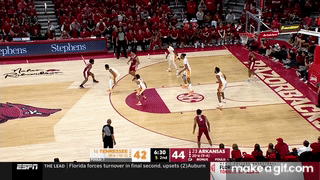
If the Vols’ offense is playing better than in the first game, they may decide that it’s fine to gamble on a zone in hopes that the Hogs cannot be efficient with a heavy diet of 3-pointers. But if it’s a low-scoring nailbiter again, I’m not sure they want to risk a dagger 3-pointer.
Keys to the Game
- Umude time. Notae struggled in the first matchup, fouling out with 13 points in 24 minutes. But Umude was a total nonfactor on offense: 5 points, 4 rebounds, +0.4 game score in 39 minutes. He’s had four great games in his last six, but that was one of the bad ones. If he comes up with a big performance, Arkansas has a shot.
- Deny the dribble drives. Tennessee’s offense loves to attack early in the possession and will get its guards downhill if the defense allows. Don’t expect the block/charge to be officiated the way it was in Fayetteville, especially with all the energy Rick Barnes has spent complaining about it. Chandler, James, and Vescovi bullying their way into the lane will lead to easy baskets and fouls against the Hogs. Make Tennessee try and win with contested 3-pointers and long midrange jumpers — if they hit those, just tip your cap to them.
- Clear the defensive boards. Arkansas’ first-shot defense has been among the nation’s best for almost two months solid. But defensive rebounding has been an issue in recent games. Tennessee is great at tipping missed shots back out, so the Hogs must get into good position and be sure-handed when the shot goes up.
The latest from Fayette Villains, straight to your inbox
Enter your email to subscribe and receive new post alerts and other updates. You can unsubscribe at any time.
